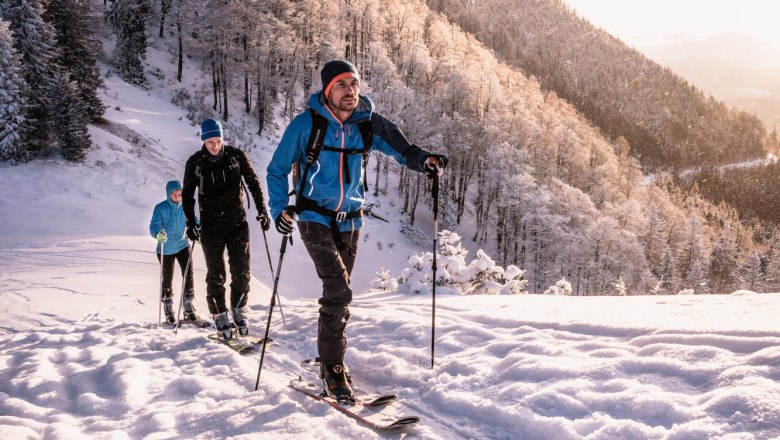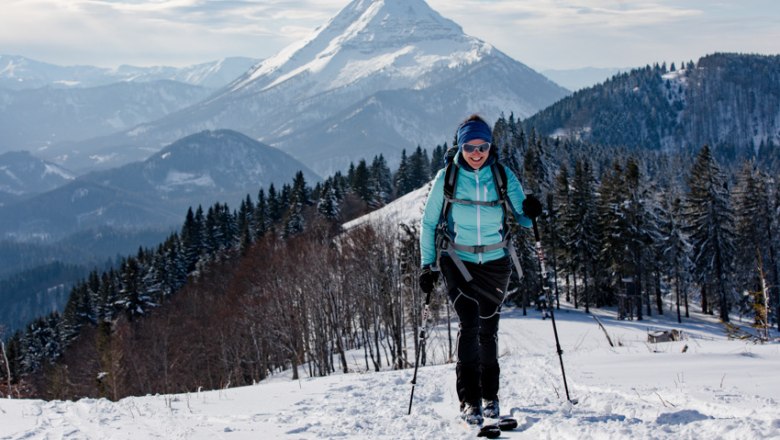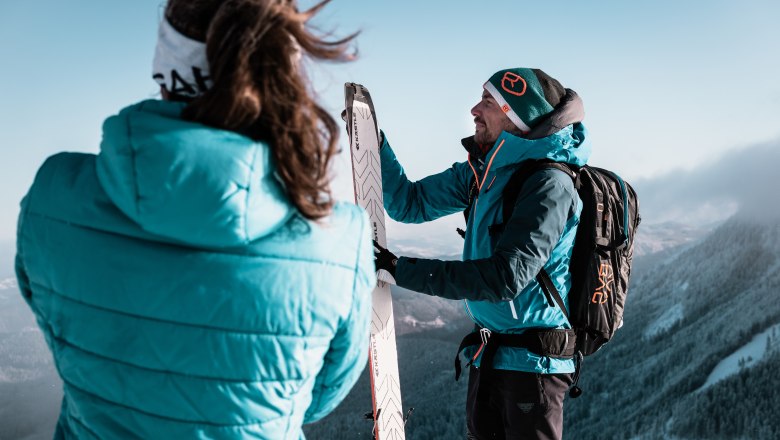Ski Touring in Lower Austria
Lower Austria fills ski mountaineers with enthusiasm with its range of options for beginners and professionals alike.
We’ve collected all the top spots of Lower Austrian touring mountains for existing and aspiring ski mountaineers. To ensure that safety doesn’t fall by the wayside, we recommend booking guided tours.
With climbing skins on a ski tour, ascend the wonderful slopes of the Muckenkogel, Schneeberg, etc. Tired but happy, with a view from the summit down into the valley. Then - worth all the effort and totally liberating: the descent on pristine slopes and fresh powder snow!
Correct preparation and equipment
Proper preparation and equipment are a major success factors for eventful and, above all, beautiful ski tours. Every ski tour should be well planned and the daily avalanche bulletin and the weather forecast should be noted. Do not leave the secured piste without an avalanche beacon that is switched on, an avalanche shovel and probe. An avalanche airbag backpack is a useful piece of protective equipment. First-aid dressings, bivouac sack and mobile phone round off the equipment. If in an emergency: Ring 140, the Alpine emergency number. All open air activities should take place whilst treating nature with maximum respect.
We therefore request that tours are always carefully planned and that safety equipment is always taken, or do not go on the ski tour if in doubt!
Courses for beginners and guided tours with the mountain guide
Lower Austria’s highest mountain is not just one of the most popular excursion sites in the Vienna Alps during summer, it is also true of the winter months, when the mountain, covered in snow, truly lives up to its name. The Schneeberg (2,076 m) adventure becomes an unforgettable experience when sporty tourers clip their skis on after the ascent and weave their way through powder snow and down into the valley. Various variants in different degrees of difficulty are available to skiers, from steep descents to leisurely trails. Those who have the endurance like to strike out towards the Wurzengraben (2,038 m). As you are on Alpine territory on the Schneeberg, the first place to visit should always be Peter Groß’s ski and mountaineering school in Puchberg, where professional ski guides can be booked. The school provides guided ski tours, starter courses for those who are interested, free ride adventures and ice climbing courses.
Ski tours away from major trails
The Tirolerkogel (1,377 m) in Annaberg is one of the most popular mountains for tours in the Mostviertel, and not just because the mountain hut at the summit, the Annaberger Haus, is also managed in winter. The reward for the one-and-a-half hour climb comes in the form of glorious views, which reach as far as the Hochschwab and the Gesäuse in good weather. On the other hand, in Göstling an der Ybbs you climb from Hochmoor Leckermoos to the Ringkogel (1,688 m). One of our favourite mountains for ski tours in the Mostviertel is the Göller (1,766 m) in St. Aegyd, as the breathtaking views of the surrounding summits are simply unforgettable. An equally popular tour leads to the Muckenkogel (1,248 m) in Lilienfeld, which is readily combined with a trip to the Lilienfelder Hütte. Those who have no experience in Alpine climes should be accompanied by a mountain or ski guide, such as from an alpine club.
Respecting flora and fauna
Healthy forests and intact ecosystems are indispensable habitats and recreation spaces for people, animals, and plants. They make a considerable contribution to our quality of life. Treating fauna and flora with respect is therefore of paramount importance. For this reason, the Austrian Federal Forest Authority, the Austrian Alpine Association and the Austrian National Tourist Board has prepared the following rules that should be followed by those on ski tours to protect flora and fauna.
- Wild animals reduce energy uptake in winter, use only the bare minimum and require quiet areas to which they can withdraw. Ensure that they are not disturbed by staying on marked paths and trails and avoid making unnecessary noise so that they are not unnecessarily scared.
- Forests that protect against avalanches, masses of snow, mud flows and other natural hazards should be protected and not entered.
- Reforestation and areas of new growth are particularly sensitive and require protection. In particular, small plants are easily overlooked below the blanket of snow. Sharp edges of skis can damage the young forest and harm young plants.


